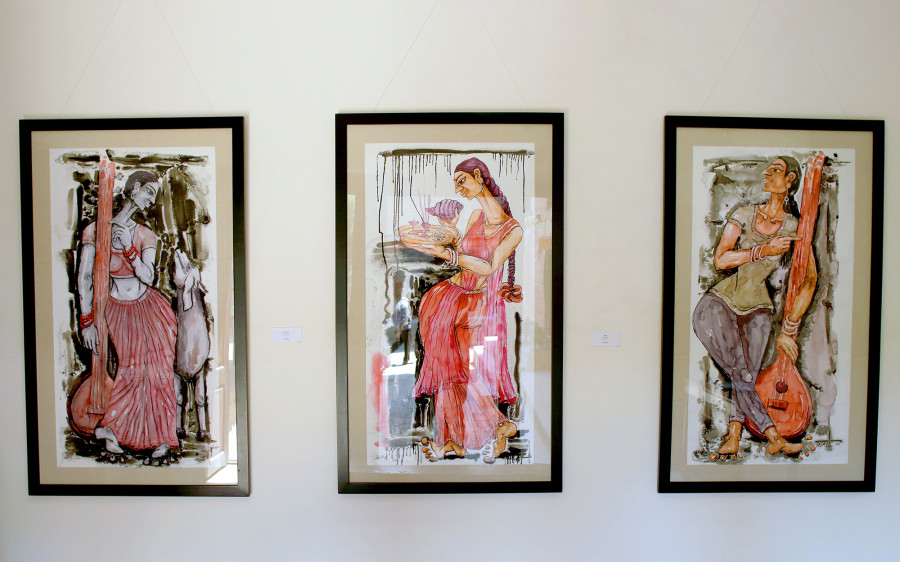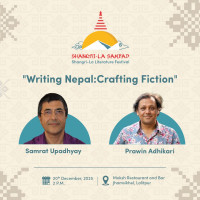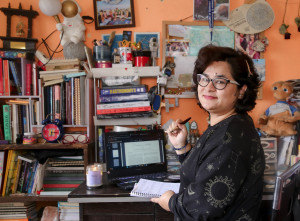Culture & Lifestyle
Umesh Shah’s lays bare his history, hopes and desires in ‘Rhythm in Roots’
In his latest exhibition, Umesh Shah gets as personal as one can get with his/her art—combining his childhood, admiration for women, and his thoughts on humanity
Abani Malla
Umesh Shah’s paintings portray nothing unusual. The subjects of his ongoing exhibition ‘Rhythm in Roots’ are objects we see around everywhere—women, men, animals, and a few instruments.
But if you study his work carefully, you realise its unsuspecting power that can take you places. With each of his piece, he gently assists viewers to travel with him, decades back to Nepal’s eastern Tarai, to that little village in Sarlahi where he was born. His brush
strokes are rough, uneven and appear as if drawn casually, but each stroke is heavy with memory.
‘Rhythm in Roots’, the artist’s sixth solo exhibition, is a collection of such personal pieces gathered from his childhood—growing up in homes that featured majestic Mithila murals drawn by his grandmother. Shah’s world is simple, and so is the message he wants to deliver through his art with this exhibition.
While his work delves deep into his childhood, it also reflects Shah’s silent protest against the Ghumto pratha—which requires women to cover their head, especially when among older male in-laws—and how he views women.
“It was important for me to cast them as protagonists in my art this time,” he says.
One of his more interesting works on display is Tikuli, in which we see a woman holding a mirror while pointing an index finger at it—as if interacting with herself.
She appears lost, immersed in her own reflecting company.

“I wanted to show how women should be able to express and enjoy their time, especially by themselves, in society,” says Shah. “They should not be limited, even in their imagination.”
Shah’s imagery of women has uniform facial traits—long neck, pointed nose, wide horizontal almond-shaped eyes, cream skin—and are accoutred in a traditional sari and choli embedded with tribal designs in their borders. They’re reminiscent
of women from Mithila paintings, but “they have a touch of modernity”—they represent women who break societal chains, who are expressive and liberated.
Shah’s art style is intriguing, and it started taking shape when he was quite young. He lived with his grandmother, and drew inspiration from her Mithila art. His current style came into place much later while pursuing a Bachelor’s degree in Kathmandu University School of Arts. He admired tribal and native art styles like the Egyptian frescos and thus researched on them to develop his own style by combining his inspirations.
“I always wondered how people from centuries ago could draw such images inside the pyramids,” says Shah. His admiration for the art forms is evident in his work, which relies heavily on the traditional Mithila artstyle and Egyptian bold borders.
Sometimes, Shah also likes to take inspiration from Hindu mythology. In another piece, Journey in Love, he has represented his love story depicting his wife and himself riding a horse-drawn carriage—an image inspired from the Mahabharata.
“My wife and I had a conflicting relationship with their families,” he says, which ultimately led them to elope. “I think that’s how we would have run away if there weren’t cars available,” says Shah.
His paintings also usually have dark-stroked backgrounds to create an illusion: of another narrative taking place in the background, something beyond the viewer’s reach, while simultaneously presenting the protagonist and their activities on focus. His profound work shows his desire to always push boundaries.
And it is this drive to always strive for more that led him to live with renowned etching artists Uma Shankhar Shah and Dr Seema Sharma Shah in 2003. The couple, who are mentors to him, introduced him to etching. Since 2017, Shah started experimenting with printmaking himself.
Some of these experiments are displayed on parallel walls at the exhibition. His etching series provide a clearer picture of his home town than his paintings. Although they’re
presented in different scenes and among props, Shah’s etchings portray a shared message—how humans can coexist with animals in harmony.
Shah’s pieces are as personal as one can get with his/her art—combining his childhood, admiration for women and their aesthetics, and his thoughts on humanity. And although Shah has been exploring cities and places since 2002 when he left for college, his art—no matter how far the imagination stretches—still remains close to his home, and with people who have made homes within him.
Rhythm in Roots is on display at Image Ark, Patan, from May 25 to May 30. The place opens from 10 am to 5 pm.




 11.12°C Kathmandu
11.12°C Kathmandu
.jpg&w=200&height=120)














